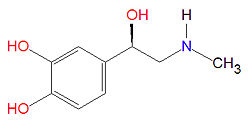Epinephrine
|
| |||||||
| (-)-epinephrine | |||||||
| |||||||
| Uses: | natural hormone | ||||||
| Properties: | |||||||
| Hazards: | |||||||
| |||||||
Epinephrine (or adrenalin) is a sympathomimetic and catecholamine that is a "active sympathomimetic hormone from the adrenal medulla in most species. It stimulates both the alpha- and beta- adrenergic systems, causes systemic vasoconstriction and gastrointestinal relaxation, stimulates the heart, and dilates bronchi and cerebral vessels. It is used in asthma and cardiac failure and to delay absorption of local anesthetics."[1]
Administration
As the dose of epinephrine is sometimes expressed as a ratio only (1 mL of 1:1000) or a concentration only (1 mg in 1 mL), medical errors in administration may be made. [2]
Subcutaneous and intramuscular administration
Epinephrine is supplied as 1 mg/mL (1 mL, 30 mL) which is a 1:1000 solution. The dose for adults with immediate hypersensitivity reactions is 0.3-0.5 mg (0.3 to 0.5 ml) every 15-20 minutes.
Intravenous administration
Epinephine is supplied as 0.1 mg/mL (10 mL) which is a 1:10,000 solution. The dose for adults during cardiac arrest is 1 mg every 3-5 minutes.
Uses
The uses of epinephrine include treatment of anaphylaxis and being a cardiotonic agent.
References
- ↑ Anonymous (2025), Epinephrine (English). Medical Subject Headings. U.S. National Library of Medicine.
- ↑ Wheeler DW, Carter JJ, Murray LJ, et al (January 2008). "The effect of drug concentration expression on epinephrine dosing errors: a randomized trial". Ann. Intern. Med. 148 (1): 11–4. PMID 18166759. [e]
